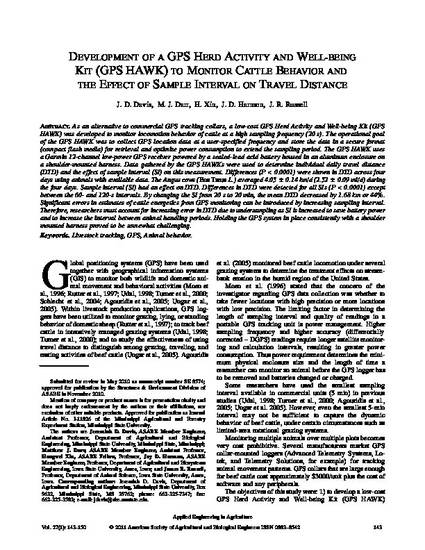
As an alternative to commercial GPS tracking collars, a low-cost GPS Herd Activity and Well-being Kit (GPS HAWK) was developed to monitor locomotion behavior of cattle at a high sampling frequency (20 s). The operational goal of the GPS HAWK was to collect GPS location data at a user-specified frequency and store the data in a secure format (compact flash media) for retrieval and optimize power consumption to extend the sampling period. The GPS HAWK uses a Garmin 12-channel low-power GPS receiver powered by a sealed-lead acid battery housed in an aluminum enclosure on a shoulder-mounted harness. Data gathered by the GPS HAWKs were used to determine individual daily travel distance (DTD) and the effect of sample interval (SI) on this measurement. Differences (P < 0.0001) were shown in DTD across four days using animals with available data. The Angus cows (Bos Tarus L.) averaged 4.05 ± 0.14 km/d (2.52 ± 0.09 mi/d) during the four days. Sample interval (SI) had an effect on DTD. Differences in DTD were detected for all SIs (P < 0.0001) except between the 60- and 120-s intervals. By changing the SI from 20 s to 20 min, the mean DTD decreased by 1.68 km or 44%. Significant errors in estimates of cattle energetics from GPS monitoring can be introduced by increasing sampling interval. Therefore, researchers must account for increasing error in DTD due to undersampling as SI is increased to save battery power and to increase the interval between animal handling periods. Holding the GPS system in place consistently with a shoulder mounted harness proved to be somewhat challenging.
Available at: http://works.bepress.com/jay_harmon/30/

This article is from Applied Engineering in Agriculture 27, no. 1 (2011): 143–150.